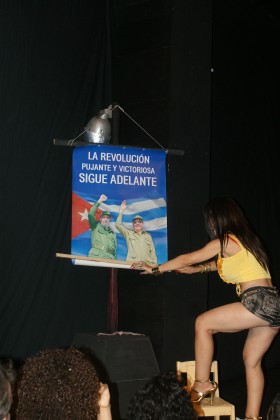
Rhapsody of the Mule and the battlefield diary to eternal memory of the slippery Ciervo demonstrated the ways in which El Ciervo Encantado’s performances erase the line between categories like inside/outside, performance/reality, and aesthetics/politics. Always in relation to an urban space (Havana), to a geographic space (Cuba/the Caribbean/island-archipelagos), and to a historic space, the beings embodied by the members of the group and its director have a dialogue with the audience and question different dynamics that are as much Cuban as they are intrinsically Caribbean: insularity and archipelago, isolation and opening, insilio (exile within) and diaspora, crossroads and detours. The unresolved Caribbean multiculturalism, always in the process of development, the relation between memory and creativity, between personal memory, collective memory, and history, and the new dialogue established between performance, the artist/individual, and the audience-turned-actor occur through the poetics of the mangrove on the basis of a game between being and presence. The language of this game/performance, as the mask the actors use, conceals in order to reveal not only personal concerns, but also social, cultural, and historical ones. For El Ciervo Encantado, to know one’s self necessitates the knowledge of where one comes from, where one is, and where one wants to be. It is here that the poetics of the mangrove and the political impulse of performance intersect. In those local and ephemeral moments of a performance, “intervals of political subjectivation” can occur: those moments in time that are formed in between identities, in between spaces that can be appropriated in defiance and recognition of the places that have been assigned to us. If the audience that follows them and the audience that stumbles upon them enjoys them despite the devastation, it is perhaps because the performances of El Ciervo Encantado in the urban Cuban/Caribbean mangrove sometimes unconsciously open a window onto Rancière’s political being: “the political being-together is a being-between: in between identities, in between worlds” (2006, 71). In a society where politics is manifest through a language of “siege” and “battles,” El Ciervo Encantado’s performances re-signify public space as a place where being-together and imagining a different politics and future is possible.